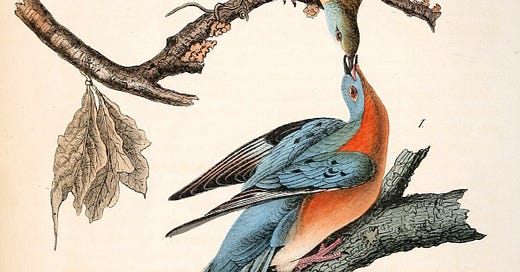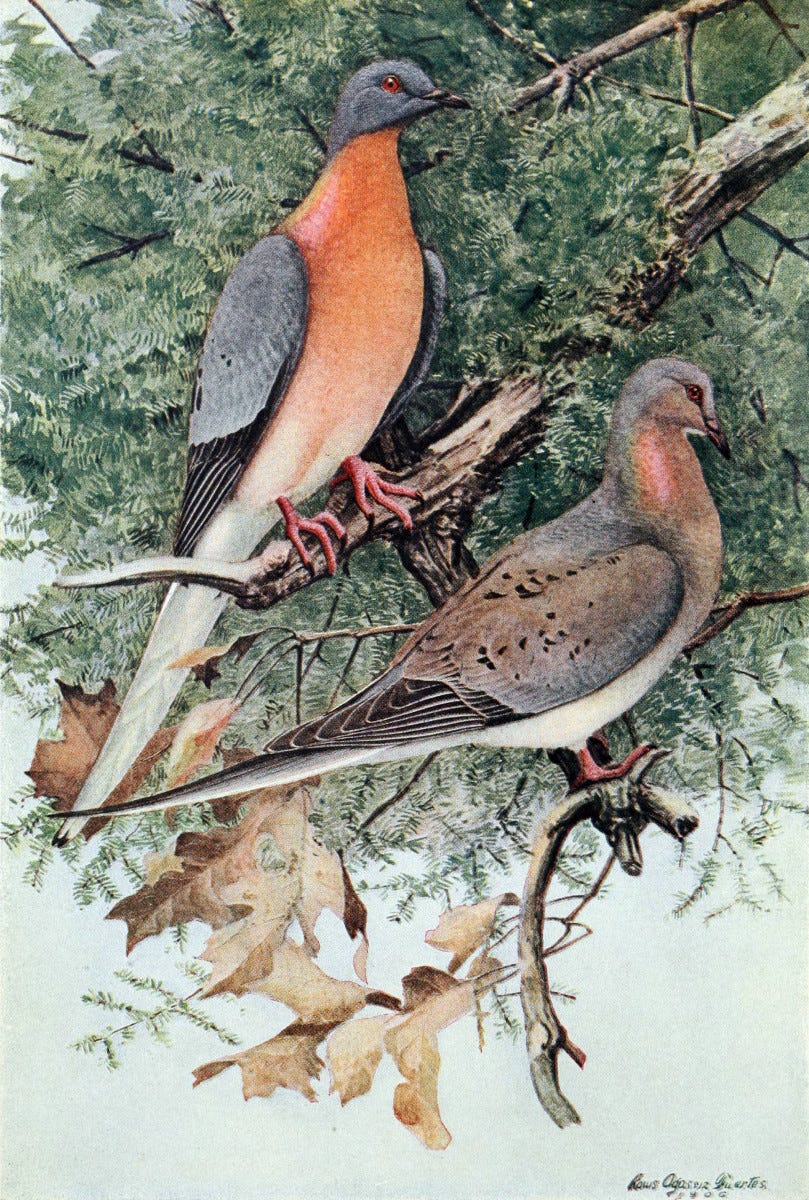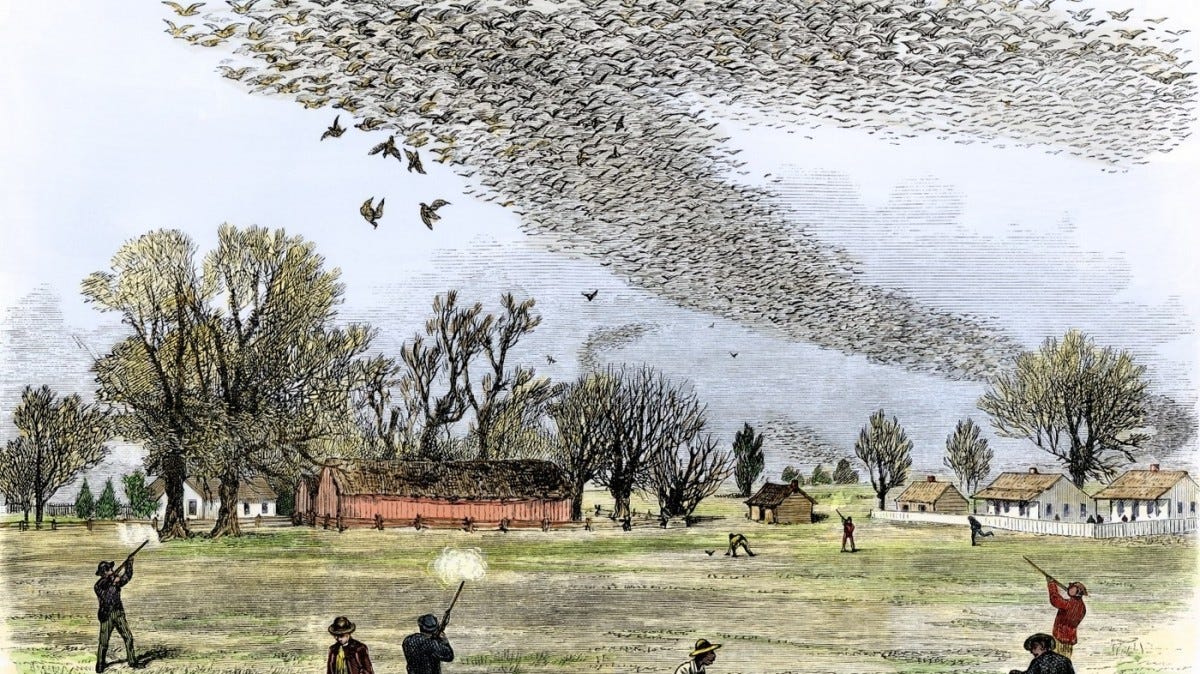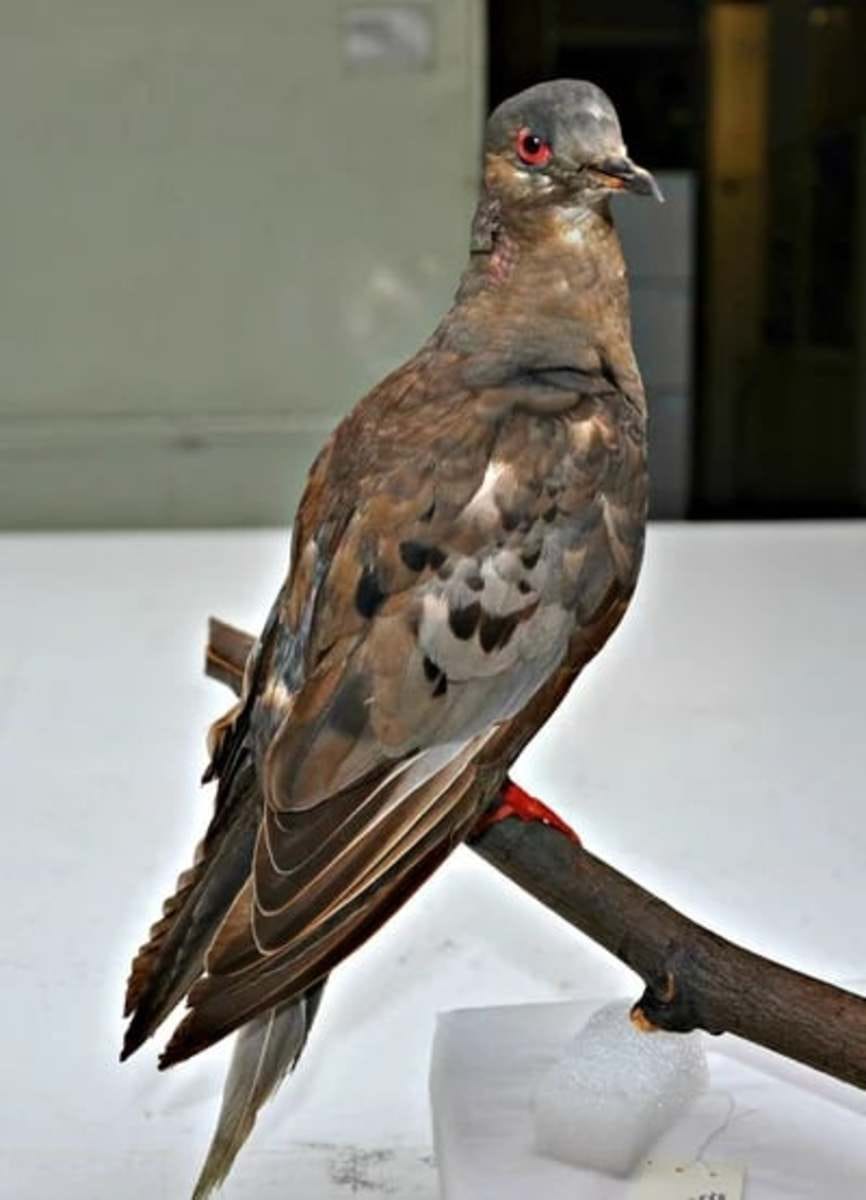Passenger Pigeons: A Journey From Abundance to Extinction
How history's most plentiful bird vanished
Flocks that Darkened the Skies
The passenger pigeon (Ectopistes migratorius) was a species unlike any seen before or since. Believed to be the most abundant bird of all time, these pigeons once numbered in the billions. Their nomadic nature had them frequently on the move, impossible to ignore.
Those who were lucky enough to witness these incredible migrations reported that the sky would darken as the birds passed overhead and would stay that way for the hours or days that it took the entire flock to move through.
Huge colonies of them would roost and nest together. The weight of so many passenger pigeons on the branches would break many of them, at times leaving behind an area that appeared as if it’d been hit by “tornadoes or hurricanes.” This was a bird that shaped its environment in more ways than one.
So how did this once unimaginably ubiquitous species go extinct?
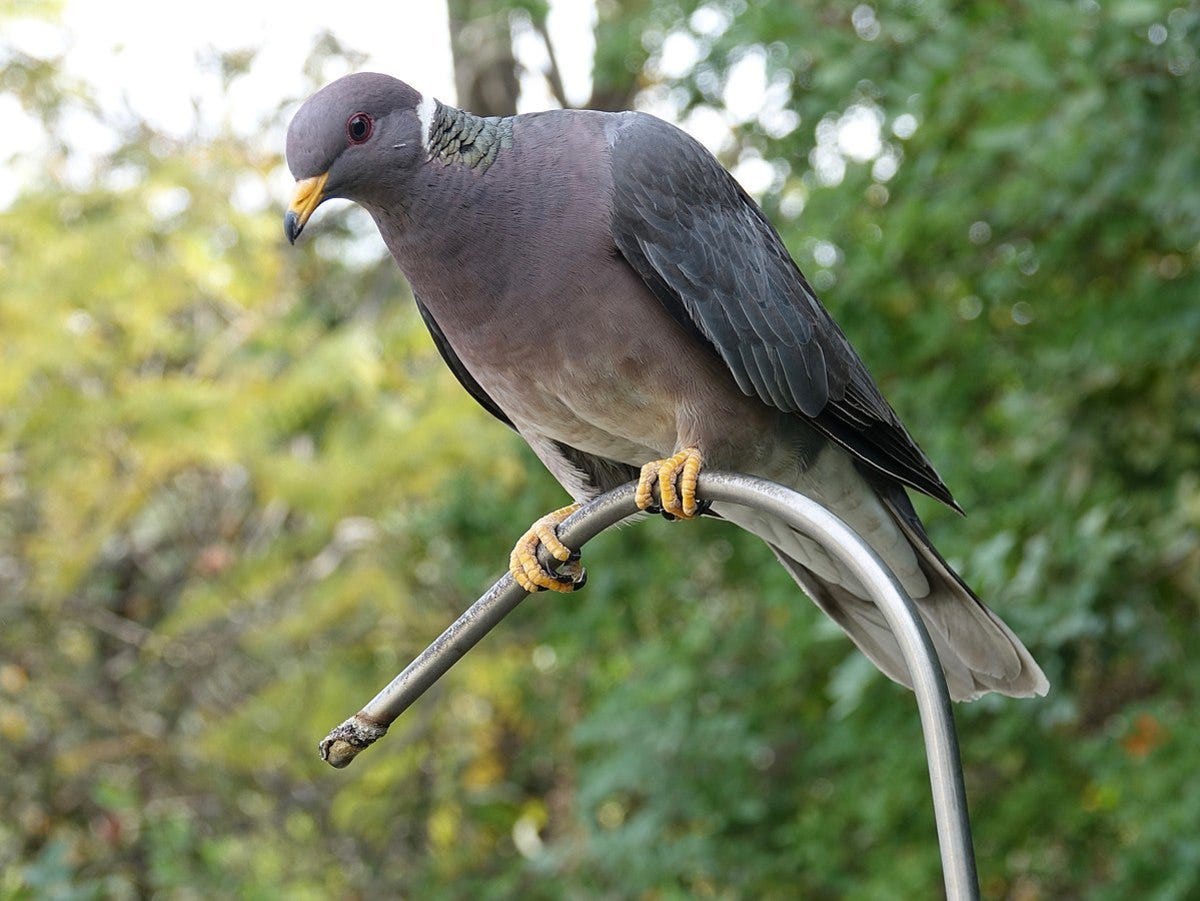
Passenger Pigeons
The genus name Ectopistes means “wandering” or “moving about.” Their species name, migratorius, is another nod to their nomadic tendencies. Similarly, the passenger pigeon’s common name derives from the French passager, which translates to “passing by.”
So it’s clear that humans found this aspect of their behavior to be one of the most noteworthy.
Ornithologist Mark Catesby included the first description of the passenger pigeon in his book, The Natural History of Carolina, Florida and the Bahamas. Completed in 1732, this was the earliest published account of North America’s flora and fauna. Additionally, Cateby’s illustration of the pigeon is believed to be the first official depiction of the bird.
Belonging to the family Columbidae, the pigeon’s exact scientific classification beyond that was a point of confusion for many years. They somewhat resembled the smaller mourning dove, which led Swedish botanist and taxonomist Carl Linnaeus to classify both species as Columba macroura. (Side note: this genus name wouldn’t stick for the mourning dove either, whose scientific name is now Zenaida macroura.)
However, it’s important to note that Linnaeus likely based this conclusion off of Catesby’s illustration and description of the passenger pigeon, along with naturalist George Edwards’ description of the mourning dove. There is no evidence that Linnaeus ever saw a specimen himself.
Passenger pigeons would eventually be placed in the genus Ectopistes in 1827 by English ornithologist William John Swainson. The oldest fossil of Ectopistes was recovered from North Carolina’s Lee Creek Mine and dates back to 5.3 to 3.6 million years ago, in the Pliocene Epoch.
So far, more than 130 fossils of passenger pigeons have been discovered in the United States, some dating as far back as 100,000 years (Pleistocene Epoch).
Interestingly, genetic studies in recent decades have revealed that the closest living relative of the passenger pigeon is actually the band-tailed pigeon (Patagioenas fasciata), not the mourning dove. North America’s largest pigeon, the band-tailed pigeon can be found from Canada to as far south as Argentina.
Morphology, Diet, and Migration Habits
Passenger pigeons were sexually dimorphic, meaning that the males and females possessed different physical characteristics, as well as being behaviorally distinct from one another.
Male pigeons were blue-gray and red with iridescent feathers on their necks, which could variously appear as pink, green, violet or metallic bronze depending on the lighting. Females were smaller and their plumage was more muted in color.
This was a bird of “transcendent beauty,” according to Reverend E.C. Dixon, who saw them nesting in 1882.
The diet of this species consisted of insects (ants, locusts, snails, earthworms, and larvae), seeds, nuts and many types of fruit. In all, they ate at least 42 genera of plants and also enjoyed domestic crops, such as wheat, corn, rye, hemp and buckwheat. However, their preference was for hard mast, including beechnuts, chestnuts and acorns.
“It is a wonder how pigeons can swallow acorns whole,” marveled Henry David Thoreau in an 1859 diary entry.
Their frequent movement was largely motivated by a need for food and suitable nesting grounds. Passenger pigeons could be found throughout much of North America east of the Rocky Mountains and especially favored areas with deciduous forests.
Additionally, they often nested in large numbers around the Great Lakes region. However, they were also known to nest in smaller numbers in other places. These pigeons would spend the winter as far south as Texas, the Gulf Coast, and Florida–specifically in swampy or forested spots.
The birds were quite well-adapted for long-distance flight and could reach speeds of up to 62 mph.
Influence on Ecosystem
Studies have indicated that the behavior of passenger pigeons had a noticeable impact on the evolution of the masting trees they so loved.
For example, white oaks developed an unique pattern of masting in the fall, when fewer of these birds would have been around. This evolutionary adaptation made it possible for white oaks to become the dominant species of tree in areas where passenger pigeons were more abundant in the spring.
Similarly, red oaks evolved different sizes of seeds, with some being too large for the pigeons to consume, allowing them to evade predation and eventually grow into trees.
As this species traveled and roosted in such large numbers, they would produce so much excrement in some places that it would kill off some plants, while also adding a great deal of nutrients to the soil and helping other plants to thrive.
These and other factors, like seed dispersal, have led many to consider the passenger pigeon a keystone species—an animal or plant species that has a significant impact on its ecosystem and whose absence would lead to dramatic changes.
A Bird of Many Names
While it was still extant, the passenger pigeon was a bird that captivated many—awestruck at their abundance—and inspired numerous names.
Some of these names included “blue pigeon,” “wandering long-tailed dove,” “wood pigeon,” “wild pigeon,” and “tourte” in New France (modern-day Canada).
To the Lenape they were “amimi.” The Seneca called the birds “jahgowa,” which translated to “big bread” and referenced the fact that they were a food source. They were also known as “omiimii” by the Ojibwe, ori’te by the Mohawk, “mimia” by the Kaskaskia, and, poignantly, “putchee nashoba” (“lost dove”) by the Choctaw.
How Did They Sound?
The call of the passenger pigeon was variously described by observers as being deafening (due to the sheer number of birds making the sounds at once), harsh, “bell-like,” clucks, twitters, and coos. Additionally, the females were said to be quieter than the males.
Some stated that one call was a “keck” sound; whereas, at other times they sounded a “tete! tete! tete!” The pigeons reportedly made little croaking noises while making their nests.
They made “shrieks and chatters and clucks instead of cooing,” recorded scientist Wallace Craig, who studied captive passenger pigeons.
However, others said that they did make cooing sounds as well. As with many species of birds, they had different vocalizations that they used depending on the situation.
How Many Were There?
At their peak, it is believed that there were as many as 3-5 billion passenger pigeons on the planet—an astounding number—and that they might have accounted for as much as 40% of bird life in North America at one time.
In 1866, there was a flock of pigeons passing overhead in Ontario that was estimated to be one mile wide and as much as 310 miles long, containing perhaps as many as 3.5 billion birds. They took 14 hours to move through the area.
A 2014 genetic study indicated that their population had fluctuated over the past one million years, likely in connection with the availability of mast. A few years later, another study—which involved sequencing the genome of two passenger pigeons, as well as analyzing the DNA of 41 others—showed that their numbers had been stable for roughly 20,000 years before their ultimate extinction.
Historical Observations and Accounts
“Before sunset I reached Louisville, distant from Hardensburgh fifty-five miles,” said ornithologist John James Audubon of an encounter in 1813. “The Pigeons were still passing in undiminished numbers, and continued to do so for three days in succession. The people were all in arms. The banks of the Ohio were crowded with men and boys, incessantly shooting at the pilgrims, which there flew lower as they passed the river. Multitudes were thus destroyed. For a week or more, the population fed on no other flesh than that of Pigeons, and talked of nothing but Pigeons.”
The earliest European to take note of the species was French explorer Jacques Cartier in 1534. Many other historical figures would go on to make observations of the pigeons as well, including Samuel de Champlain and Cotton Mather. Ornithologist Alexander Wilson also witnessed huge flocks of the birds.
In an 1858 paper, naturalist Alfred Russel Wallace spoke of their ability to proliferate, despite having smaller clutches than many other species of birds.
“Perhaps the most remarkable instance of an immense bird population is that of the passenger pigeon of the United States, which lays only one, or at most two eggs, and is said to rear generally but one young one. Why is this bird so extraordinarily abundant, while others producing two or three times as many young are much less plentiful? The explanation is not difficult. The food most congenial to this species, and on which it thrives best, is abundantly distributed over a very extensive region, offering such differences of soil and climate, that in one part or another of the area the supply never fails.”
He continued:
“The bird is capable of a very rapid and long-continued flight, so that it can pass without fatigue over the whole of the district it inhabits, and as soon as the supply of food begins to fail in one place is able to discover a fresh feeding-ground.”
An early account of Europeans killing large numbers of passenger pigeons comes from 1565 and was written by French explorer Rene Goulaine de Laudonnière.
"There came to us a manna of wood pigeons in such great numbers that over a span of about seven weeks, each day we killed more than two hundred with arquebuses (long guns) in the woods around our fort.”
Author Bénédict Henry Révoil spoke presciently of the birds in 1856:
“Everything leads to the belief that the pigeons, which cannot endure isolation and are forced to flee or to change their way of living according to the rate at which North America is populated by the European inflow, will simply end by disappearing from this continent, and, if the world does not end this before a century, I will wager… that the amateur of ornithology will find no more wild pigeons, except those in the museums of Natural History.”
Downfall
Native Americans often hunted passenger pigeons, occasionally using nets to capture a large number of them at once. Some tribes would only kill juvenile pigeons, resolving to leave the adults alone—and it was actually considered a crime by some tribes to kill the adults. The Seneca would even make an offering of jewelry and wampum to the older birds in a ceremony before hunting the juveniles.
It appears that Native Americans managed to co-exist with the species for a long time and used more sustainable hunting practices than Europeans would–the veracity of this theory is seemingly confirmed by the fact that passenger pigeons still existed in such abundance by the time European settlers arrived in North America.
The pigeons became a popular and inexpensive commercial food source, which led to the slaughter of a great deal of them for centuries. In 1771, for example, 50,000 of them were sold in a market in Boston.
Interestingly, some colonists viewed the pigeons as a bad omen, certain that ill luck would follow in the wake of their epic migrations
It was a common belief in the 18th and 19th centuries that there was medicinal value in consuming or utilizing certain parts of these birds–their stomach lining was considered a treatment for dysentery, their blood for eye problems, and their dung for lethargy, stomach ailments and headaches.
Their feathers were regularly used for bedding. In 1822, a New York family recorded having killed 4,000 pigeons in a single day for their feathers.
Another method for capturing them was tunnel nets, which could gather up to 3,500 birds at once. Some hunters would merely fire blindly into the air at a flock and bring many pigeons down that way.
They were also used as live targets in shooting tournaments.
Their largest recorded nesting took place in Wisconsin in 1871. It covered an estimated 850 square miles and included as many as 136 million pigeons.
By the late 1870s, it had become apparent that there were fewer passenger pigeons than there had been in the past. During this decade, large nesting events occurred with less frequency and happened only around the Great Lakes region.
What is believed to be the final incidence of a large gathering of nesting birds occurred in Petoskey, Michigan, in 1878. Estimates placed the site at 40 miles long, 3-8 miles wide and up to 150,000 acres in size.
Hunters in Petoskey killed roughly 50,000 birds every day for around five months. The species would limp on after this, but would never fully recover. A witness to the slaughter, H.B. Roney, attempted to advocate for the protection of the pigeon, but was met with criticism and accused of exaggerating the dire nature of the situation.
Decades earlier, in 1857, a bill that aimed at protecting passenger pigeons was proposed to the Ohio State Legislature. However, the foresight to understand the necessity of this measure wasn’t there. A Senate report deemed the bill unnecessary as the pigeons were “wonderfully prolific.”
By the late 19th century, the birds, now understandably wary of humans, would abandon their nests at the first sign of people in the area. The final record of a passenger pigeon egg in the wild came from Minneapolis in 1895.
Passenger Pigeons Vanish in the Wild
A lone female pigeon was shot by a boy named Press Clay Southworth in Pike County, Ohio, in 1900. His parents soon had the bird taxidermied. The specimen, nicknamed “Buttons” for the buttons that had been used for its eyes, was donated to the Ohio Historical Society in 1915.
For years, this was mistakenly believed to be the final wild passenger pigeon. However, Joel Greenberg, author of A Feathered River Across the Sky, discovered an official record of a male that was shot in Indiana on April 3rd, 1902.
Yet there were still occasional reports of the birds in the wild for years afterwards. Ornithologist Alexander Wetmore claimed to have witnessed a pair in Kansas in 1905.
President Theodore Roosevelt reported seeing a “flock of about a dozen two or three times on the wing” while staying at his cabin in Pine Knot, Virginia, on May 18th, 1907. This account was corroborated by a local resident who often traversed the wooded areas of Pine Knot and had also seen the birds.
Ultimately, it’s impossible to say with any degree of certainty when the passenger pigeon went extinct in the wild.
Martha, the Last of Her Kind
In the early 20th century, the last captive passenger pigeons were divided into three groups—one which lived in Milwaukee, another in Chicago, and the last at the Cincinnati Zoo. The final living pair was George and Martha, who resided at the Cincinnati Zoo. They were, by some accounts, named after President George Washington and his wife Martha.
George passed away in 1910. The following year, Martha had a stroke, which sadly left her weakened in her final years. Disturbingly, some visitors to the zoo would throw sand at the poor bird, in an effort to get her to move around more. This behavior led to her cage being roped off from the public.
On September 1st, 1914, Martha—the final passenger pigeon—died. Her exact age is something of a mystery, but 29 is the most widely accepted number. (Interestingly, the average lifespan of a passenger pigeon in the wild is unknown, but the captive birds could live for at least 15 years.)
A species that had once existed in such incredible numbers was now gone.
Martha’s taxidermied body resides at the Smithsonian’s National Museum of Natural History. She was an "endling" or the last of her kind.
De-Extinction
The passenger pigeon is often brought up in the context of de-extinction, largely because this species provides a particularly egregious example of human-caused extinction. Theoretically, this might be achieved one day, at least in some form.
As their genome has been sequenced, scientists could, in theory, identify their unique genes and then edit them into the genome of one of their closest living relatives (band-tailed pigeons, perhaps). This would potentially allow scientists to bring the passenger pigeon back as a hybrid and to partially recover a lost remnant of history.
If you would like to support my work and make a donation: Buy Me a Coffee
Sources
A Feathered River Across the Sky by Joel Greenberg
(This article was originally published on Owlcation)

